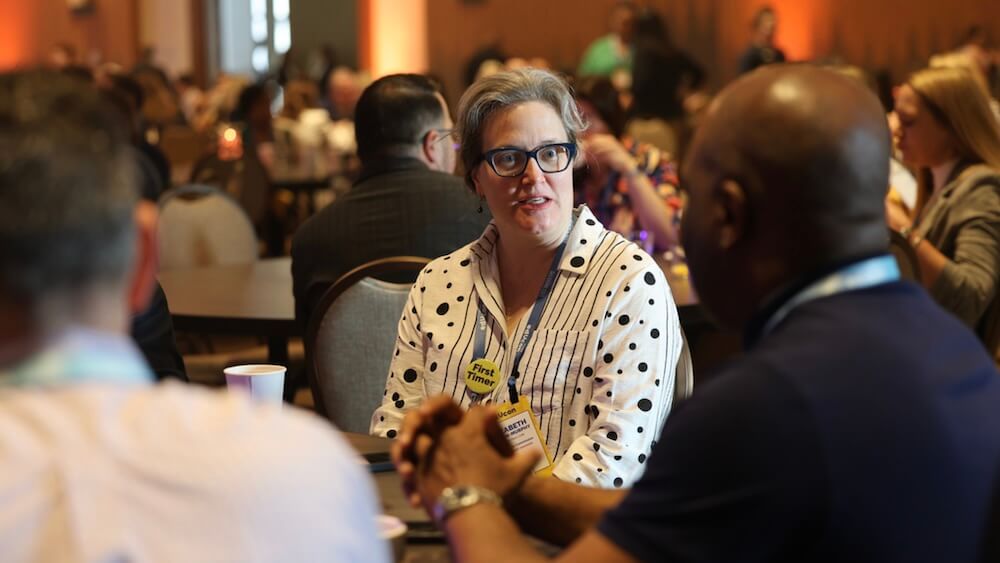


Planners’ concerns have shifted more heavily to trade and tariffs, with four out of five respondents citing a funding loss and a notable increase in logistical and cost-based challenges. Photo courtesy Jacob Slaton / Whatever Media Group
Major policy changes, on-again, off-again tariffs, and federal budget cuts in the first half of 2025 under the current administration are being felt in different ways by different events professionals. And things remain in flux, so it’s critical to keep our finger on the pulse of how professionals are navigating a shifting events landscape.
We sent our our first pulse survey to the events community in April (more than 175 participated) and the second in May (108 respondents), tweaking the questions and adding new ones to gain deeper insights. Event professionals who responded to each pulse survey were similar in background: One out of 10 are U.S. based and the majority work for associations and nonprofits. So, what has changed?
In April, the dominant focus was on the impact of executive orders, particularly around DEI and federal employee travel freezes. In May, concerns shifted more heavily to trade and tariffs, with four out of five respondents citing a funding loss and a notable increase in logistical and cost-based challenges.
In the first pulse survey, more than three-quarters of respondents said attendance was down at their events, but much of the data was qualitative. In May, respondents indicated that attendance drop-offs could be clearly measured, with 43 percent projecting declines and 39 percent reporting actual declines. In other words, anticipated impacts in April were now materializing in concrete attendance numbers in May.
How are event organizers responding? Communication and risk mitigation are still weak spots. In the first survey, only 19 percent said they had updated their travel-related communication to address travel policy changes. In May, that percentage rose by 13 points but one-third still report doing nothing at all. Preparedness is lagging behind concerns — and that may be because changes keep coming and we lack certainty about what may be next.
Here are highlights of the results of the most recent survey.
Have recent U.S. trade policy changes affected your organization’s planning or event strategy?
Yes, significantly
23%
Yes, moderately
43%
No
23%
Unsure
11%
Survey respondents experiencing effects cited:
Lower attendance in person
70%
Increased expenses
64%
Shift in attendee demographics (lower international attendance
52%
Shift in attendee demographics (lower governmental participation)
51%
Delayed logistics (e.g., speaker selection; shipments; F&B orders)
35%
Exhibitor/supplier withdrawal or loss
30%
Change in venue or event format (e.g., hybrid; smaller venues)
16%
Lower attendance overall (both in person and virtual
13%
Other*
9%
*These included fear for health while attending and more participants moving to online out of fears around border crossing.
Have you experienced cancellations or drop-off in attendance?
Yes — anticipated attendance is projected to be down
43%
Yes — actual attendance was down
39%
No
19%
What factors do you attribute these cancellations or decreased attendance to?
Lack of funding/loss of job
81%
Political reasons
64%
Visa/travel uncertainty
57%
Travel warnings
41%
None of the above
0%
Other
10%
Other responses include: businesses waiting and not willing to spend money; fear of inadequate medical attention at destination; travel freezes; concerns over travel as a trans or LGBTQ+ person; hiring freeze; economic uncertainty; DEI under attack; economic concerns.
Have you updated any of the following in response to the current political climate?
Travel communications for international attendees
32%
Contract language to mitigate future risk
32%
Speaker or content strategy
25%
Virtual/hybrid access
16%
Sponsorship model or pricing
13%
None of the above
33%
In the first survey, more than half of respondents said they had not made any changes to their event content or speaker selection in response to the political climate and only 19 percent had updated or added travel-related communications to support international attendees. Around three-quarters of respondents had not made changes to their contracts in light of the current administration policy changes.
Regarding offering hybrid access, some respondents said they are fully streaming or restructuring events to accommodate virtual audiences, while others are taking a more targeted or strategic approach — limiting access to select sessions or using it as a revenue stream. A small subset is deliberately minimizing virtual offerings to preserve in-person engagement. Some of the open-ended responses:
“We allowed accepted presenters to request virtual attendance on in-person panels for reasons specific to international travel concerns and accepted limited numbers. All panels will remain in person but presenters can participate on Zoom. Approximately 20 percent of panels are moving forward with this hybrid option.”
“Sessions are in-person or online. We allow session organizers to select which one and change the preference at least once if circumstances change.”
“Offering a post-event digital pass to access recorded premium content.”
“We are looking to create a new virtual conference to meet the needs of those unable (or unwilling) to travel to in-person meetings.”
“We offered free on-demand access to those with funding impact. They joined for a discount and received on-demand access for two months free.”
How concerned are you about the potential long-term impact of the U.S. tariffs and overall political climate on your events?
Extremely concerned
26%
Very concerned
31%
Moderately concerned
24%
Slightly concerned
14%
Not at all concerned
5%
When does your next major event take place?
May–June 2025
36%
July–September 2025
23%
October–December 2025
21%
2026 or later
20%
Are your responses based on actual registration/attendance data or projected trends?
Actual/Recorded
33%
Projected/Anticipated
32%
A mix of both
35%
Not sure
1%
What best describes your typical attendee base?
Professional or trade association
46%
U.S. corporate
44%
U.S. academic
41%
U.S. government
41%
Suppliers/Exhibitors
35%
International academic
26%
International corporate
19%
Other
6%
Most reported modest international participation. Only a small number of events (under 10) reported that more than half of their attendees were international.
What event format was used for your 2024 event?
In-person only without any virtual option
64%
In-person with small portion of content delivered virtually
32%
In-person with all content delivered virtually
4%
Virtual only
0%
What has your attendance trend been in the last three years (pre-2025)?
Increasing year-over-year
69%
Holding steady
26%
Gradually declining
3%
Sharply declining
0%
N/A or first-time event
2%
Survey analysis by Convene’s digital media editor Magdalina Atanassova and editor in chief Michelle Russell.








